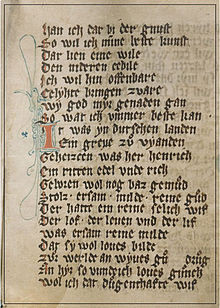- Codex Mariendalensis
-
The Codex Mariendalenis is a manuscript on vellum containing the epic poem Yolanda vu Veianen or Yolanda of Vianden. It is believed to be the work of Brother Hermann von Veldenz[1] who probably wrote the story of Yolanda's life in 1290 after her death in 1283. The work consists of 5,963 lines of rhyming couplets in Moselle Franconian which bears close similarities to today's Luxembourgish. It is therefore of particular interest to those tracing the history of the Luxembourgish language.
Brother Hermann's epic appears to have lain in the Marienthal monastery for almost four centuries after he wrote it. In 1655, the original was copied on paper by the Belgian Jesuit, Alexander von Wiltheim. At the same time, Wiltheim wrote a life of Yolanda in Latin based on Brother Hermann's Middle High German. Then in November 1999, the Luxembourg linguist Guy Berg and Yasmin Krull[2] discovered the original Codex in Ansembourg Castle, a short distance from the monastery at Marienthal.
The poem tells how Princess Yolanda gave up the comforts of her home in Vianden Castle to join the Convent of Marienthal where she later became the prioress. See further details under Yolanda of Vianden.
Acquisition by the National Archives of Luxembourg
The Codex Mariendalensis together with other documents belonging to the lords of Ansembourg were acquired by the Luxembourg state in 2008 and now form part of the collections of the National Archives and the National Library of Luxembourg.[3]
References
- Romain Hilgert: Zwei Kilometer in 700 Jahren. Story of the rediscovery of the original manuscript of Yolanda von Vianden. Retrieved 2 October 2007.
- Berg, Guy: "Der Codex Mariendalensis: Zu Wiederauffindung, Erschließung und Edition einer hochmittelalterlichen Handschrift aus dem Raume Luxemburg." In: Section de linguistique, d'ethnologie et d'onomastique de l'Institut Grand-ducal (ed.): Bulletin linguistique et ethnologique, fasc. 30 (2001), pp. 7-26.
- Moulin, Claudine: "Bruder Hermanns 'Yolanda von Vianden'. Zur Erschließung und textgetreuen Edition des neuaufgefundenen Codex Mariendalensis", in: ebda, pp. 39-45.
Footnotes
- ^ Bruder Hermann: Yolanda von Vianden. Moselfränkischer Text aus dem späten 13. Jahrhundert, übersetzt und kommentiert von Gerald Newton und Franz Lösel (Beiträge zur Luxemburger Sprach- und Volkskunde XXI, Sonderreihe Language and Culture in Medieval Luxembourg 1). Luxembourg 1999.
- ^ [1](German) Yolanda von Vianden: 3.2 Die Wiederentdeckung der Marienthaler Handschrift
- ^ Le Codex Mariendalensis et le patrimoine écrit des comtes d'Ansembourg. Archives nationales du Luxembourg. Retrieved 2 March 2009.
Categories:- History of Luxembourg
- Luxembourgian literature
- Luxembourgish language
Wikimedia Foundation. 2010.

